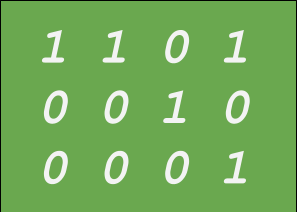What is Digital#
Digital means discrete or countable, i.e. only existing at specific levels. It is the opposite of analog (where values can exist along a continuum). For example, integers are digital, real numbers are analog. On a video game controller, the D-pad is digital, the joystick is analog.
Concept Check:
Are the following quantities digital or analog?
a person’s height
elevation on a ladder
number of jelly beans
amount of water
radio volume
Solution
A person’s height is analog.
Elevation on a ladder is digital (assuming the ladder is fixed and we are only talking about standing on the rungs.)
Number of jelly beans is digital, although I guess technically you could bite one in half and put it back in the jar you monster!
Amount of water, or any liquid, is usually considered analog because you could have any possible volume, but could technically be thought of as digital if you went down to the atomic level. You pedantic monster!
Radio volume (do people still listen to the radio?) is analog. The volume can be amplified to have any value, but I would not be surprised if most radios have a digital interface and so give the volume as a set of discrete options.
Digital electronics use a system with only two levels: 1 - High (HI) - True 0 - Low (LO) - False
Typically the physical quantity measured to determine the level is voltage. Depending on the exact system used, voltage would be interpreted like so: Anything between 2 V and 5 V is considered High, and anything below 0.8 V is considered Low. Assuming the circuit is designed correctly, a voltage in the invalid region between 0.8 and 2 V should never occur. (Note that the specific voltage levels depend on the logic family being used. The numbers above are for the TTL family which we will learn about later.)
Digital electronics (like a computer or your phone) have several advantages over analog electronics (like a guitar and tube amp or noise cancelling headphones), but they are not perfect.
- Advantages of Digital Electronics
easier to design since exact voltage not nessecary (you can round up or down to nearest digital level)
can easily store, access, duplicate, and manipulate information
accuracy and precision is easy to maintain throughout the system
less affected by noise
lower cost to manufacture
programmable, so they can have multiple (infinite?) uses
- Disadvantages
the real world is largely analog, so not trivial to interface with
higher latency and processing delays compared to analog (which operate at esentially lightspeed)
easily erasable (compare a digital photo to film)
becomes easily obsolete and unusable (e-waste, data loss through format changes)
Using only two levels for our digital system may seem like a disadvantage. Why not use three or four, or even ten different levels? The answer is simplicity. It is straightforward to make electronics where the voltage is either High or Low (or equivalently where the current is On or Off). It is much more difficult (and expensive) to make electronics with tolerances such that there are even just three well-defined states. It could be done, but the cost and complexity would be astronomical compared to a two-state system. Additionally, there is no advantage to having more levels. Two is all you need.
What if you need more than two? We use a system of binary representation.
